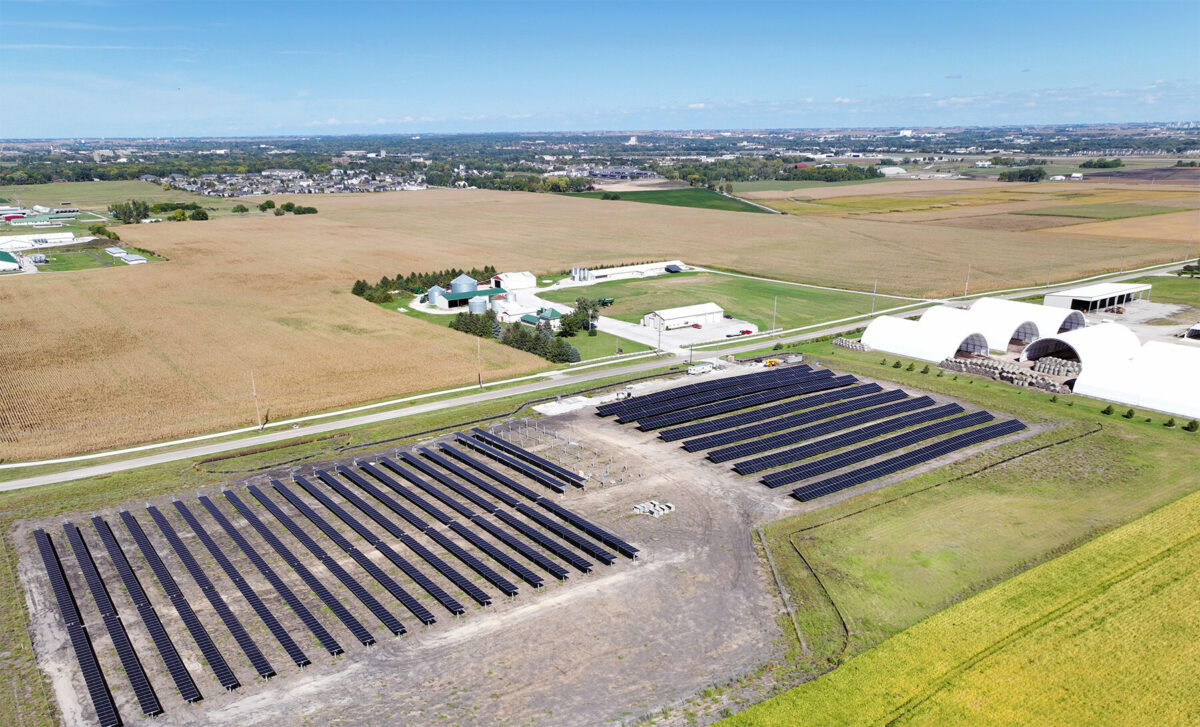Iowa State University has embarked on a study on agrivoltaics, or the co-location of farming and solar energy production, following a $1.8 million grant from the U.S. Department of Energy (DOE).
The grant funds a 1.75 MW solar array at the university, which will serve a case study site for students learning about how various horticultural and agricultural practices can mutually pair with solar.
DOE’s funding comes via a program called Foundational Agrivoltaic Research for Megawatt Scale (FARMS). The $8 million program issued six different research grant awards.
Iowa State University’s research team is led by Ajay Nair, associate professor of horticulture, Matt O’Neal, professor in plant pathology, entomology and microbiology, and Anne Kimber, director of the electric power research center.
The project is a result of a partnership between the university and Alliant Energy, the utility that owns and operates the array that sits on land leased from the university. Waldinger Corporation served as general contractor for the project, which held a ribbon-cutting ceremony on October 19. Ideal Energy was subcontracted for design of the array, which was designed with input from Iowa State researchers. Shive-Hattery, Inc. Provided civil and electrical engineering services for the project.
“As renewable energy grows, it’s important to find opportunities for these projects to benefit people, beyond just providing renewable electricity. There’s good work to be done on this front, and we hope this research and demonstration will help identify the potential for communities to benefit from agrivoltaics,” said Anne Kimber, co-principal investigator.
The solar array was built in two parts. One part is an 811 kW fixed-tilt array facing south. Six fixed-tilt rows have a standard leading edge of two feet off the ground in front and three rows have a leading edge height of five feet to test to see if higher solar arrays create better growing conditions.
The second array is a 946 kW single-axis active tracker array, which is the most common configuration for utility-scale solar projects being built today. Eighteen of the active-tracker rows are a standard five to six feet above the ground while five rows are eight to nine feet above the ground. All solar panels on the site are bifacial, meaning they generate power from both sides.
The research team plans to explore which crops thrive under a solar microclimate. The team will plant vegetables, fruits, and pollinator habitats. The project will also study how solar array maintenance effects cultivation.
“Growing these types of crops under and around a solar farm on a scalable basis is different than just growing them. We want to demonstrate that’s possible,” said Ajay Nair, lead principal investigator.
Research by Oregon State University found that solar and agricultural co-location could provide 20% of the total electricity generation in the United States. Wide-scale installation of agrivoltaics could lead to an annual reduction of 330,000 tons of carbon dioxide emissions while “minimally” impacting crop yield, the researchers said.
The paper found that an area about the size of Maryland would be needed if agrivoltaics were to meet 20% of U.S. electricity generation. That’s about 13,000 square miles, or 1% of current U.S. farmland. At a global scale, it is estimated that 1% of all farmland could produce the world’s energy needs if converted to solar PV.
Agrivoltaics can represent a win-win for farmers and solar developers. Research firm Allied Analytics suggests that the agrivoltaic market can reach $9.3 billion by 2031, growing at an annual rate of over 10%.
This content is protected by copyright and may not be reused. If you want to cooperate with us and would like to reuse some of our content, please contact: editors@pv-magazine.com.









By submitting this form you agree to pv magazine using your data for the purposes of publishing your comment.
Your personal data will only be disclosed or otherwise transmitted to third parties for the purposes of spam filtering or if this is necessary for technical maintenance of the website. Any other transfer to third parties will not take place unless this is justified on the basis of applicable data protection regulations or if pv magazine is legally obliged to do so.
You may revoke this consent at any time with effect for the future, in which case your personal data will be deleted immediately. Otherwise, your data will be deleted if pv magazine has processed your request or the purpose of data storage is fulfilled.
Further information on data privacy can be found in our Data Protection Policy.